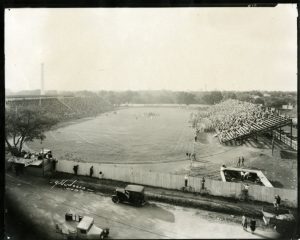This piece by former Texas Collection director Kent Keeth originally was published in The Baylor Line in September 1979, then was reprinted in Looking Back at Baylor (1985), a collection of Keeth and Harry Marsh’s historical columns for the Line. Blogging about Texas periodically features selections from Looking Back at Baylor, with hopes of sharing Keeth’s work with a new audience.
With Homecoming in full swing this weekend, it is the perfect time to take a moment and look back at how it all started. Baylor was one of the first schools to organize a Homecoming event for alumni over a century ago, and today it is one of the most widely celebrated Baylor traditions.

In 1909, when Baylor held its first Homecoming, a pattern was set which holds remarkably true even today. Though seven decades have passed, and generations of alumni have come and gone, the traditional highlights and festivities of Baylor’s annual “family reunion” have retained a remarkable likeness to those of their distant prototype.
The purpose of the original Homecoming in 1909 was “to give an opportunity for the joyful meeting of former student friends, an occasion when old classmates could again feel the warm hand-clasp of their fellows, recall old memories and associations, and catch the Baylor spirit again.” To this end members of student organizations, local alumni and representatives of each graduation class launched a campaign of correspondence and advertisements in major state newspapers, inviting all former Baylor students to spend Thanksgiving at the Homecoming celebration.
Thus on Wednesday, November 24, hundreds of graduates and former students made their appearance on the campus. Each arrivals were entertained at a mid-afternoon concert by the Baylor Band, followed by the President’s Reception and a “soiree” in Georgia Burleson Hall, a social evening when old friends could meet and relive their college days.
On Thanksgiving morning, Homecomers assembled to hear a series of five-minute reminiscences by administrators, faculty members and prominent fellow-graduates. Then, after luncheon, they viewed the first in Baylor’s perennial series of Homecoming parades through downtown Waco. Twenty-five blocks in length, the procession honored distinguished guests and student leaders, who rode in some 150 automobiles and carriages decorated in green and gold, and also featured two marching bands and hundreds of walking students.

As the parade reached the campus, bystanders hurried to Carroll field behind the Science Hall to witness an afternoon game of football. The contest was between Baylor and Texas Christian University, which at that time was also located in Waco. Appropriately, the game was won by Baylor, placing the crowning touch of success upon the university’s first Homecoming. The following account from the 1910 Round Up conveys the flavor of the occasion:
THE FOOTBALL GAME BETWEEN BAYLOR AND T.C.U.
Nearly five thousand people witnessed the final football contest of the season on Carroll Field, Thursday afternoon. For the third time of the season Baylor and Texas Christian University battled for supremacy, and in this game the Baylor Team carried off the honors. Baylor has lost only two Thanksgiving games since 1898. Inspired by such a record in the past years and by the presence of the hundreds of Home-comers, the warriors of the Green and Gold fought like real heroes.

Carroll Field was the scene of the greatest demonstration of college spirit that has been manifested for years. On all sides of the field organized bands of “rooters” with good leaders sang and rent the air with college yells, while three bands furnished music for the occasion. The grand stands were continuous glares of color, either Green and Gold or Purple and White. Between the halves the Baylor boys went through a tortuous snake dance in the middle of the field to the accompaniment of the Alessandro and Baylor bands.
Baylor played a superior game after the first ten minutes, and at only one time was the Green and Gild in danger, and then Massie, of T.C.U., succeeded in counting “three” on a place kick. Baylor scored at the end of fourteen minutes of play in the second half, when Robinson bucked the ball over in two downs when it was only four years from the coveted goal-line, where it had been carried by Isbill on a forward pass. Robinson kicked a neat goal. This play gave the victory to Baylor, as there was no further scoring during the remainder of the game. The score stood 6 to 3 in favor of the home Team. As usual on such occasions, the old bell pealed forth the glad tones of victory. Hardly ever was there such rejoicing on Baylor Campus. Even certain of the visitors, who were inclined to think that football is a doubtful sport for college youth, caught the spirit and helped to swell the should of victory.
Charles Guittard
October 20, 2017 at 9:46 amThe parade photo makes the street look muddy. Was it muddy? If so, how did the elements affect the football game? Or maybe it was clear and dry. Do you know?
leanna_barcelona
October 23, 2017 at 11:24 amThank you for your comment! From the Lariat articles the next day as well as the Baylor Bulletin and other photographs, I believe the weather was clear and dry for the parade and the game. It may appear muddy in the photo because the streets were dirt at that time and the procession of the parade would have taken a toll on them. It may have also rained the previous days, but I cannot be sure. Thank you for reading our blog!